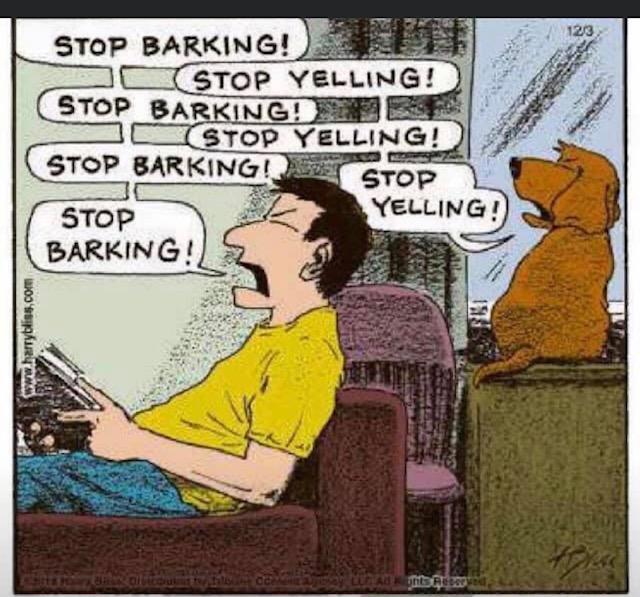.
Dogs bark due to a variety of reasons and if you want to stop your dog from barking then you need to address the underlying cause of the barking. The barking is just a consequence and if we want our dogs to be quiet, we must find out what made them bark in the first place. Barking is sometimes a symptom of another problem such as fear. Some other reasons why dogs bark include noise sensitivity which can be from doorbells, knocking, footsteps, and noises from your TV. Excitement barking during playtime, reactive barking at other dogs, and people, boredom such as leaving them outside in a garden for hours while you are at work. Barking if your dog does not get adequate exercise or brain stimulation training and enrichment, pent-up energy in dogs must go somewhere and will often come out in negative behaviours that owners do not like. Demand barking, when your dog wants something, for example, they want you to throw their ball or feed them, some owners will often give in to this demand of barking because it makes their dog be quiet, but this is only a short fix, and this trains your dog that barking works so they get what they want. Fearful dogs will often bark at the sight of what makes them fearful or uncomfortable as well as being noise sensitive. Not all barking is symptomatic of an underlying problem, often it is simple communication, such as someone is outside. It is perfectly natural for dogs to bark; this is how they communicate. I am always glad if my dog’s bark to let me know that someone is at the door, the key is getting them to stop on cue if your dog just continues to bark none stop.
One of the most common behaviours I get calls about is dogs barking when visitors arrive. If you practice door training from day dot with your puppy this should not be a problem in the future so, you will be setting your puppy up for success, and getting them to used to the sound of the door early on will be beneficial for you and your dog. (You can even teach your older dogs this exercise). The whole point of this door training exercise is for your dog to learn that when they hear knocking sounds or the doorbell, they will associate this with going to settle, first we must get the base behaviour such as getting them to like staying on their bed or towel. I start by using a towel on the floor with treats on (You can take a towel anywhere for other environments). To start the exercise, wait for your dog to go on the towel or bed on their own when they exhibit this behaviour they will receive the treats on the towel (You can also use a clicker and treats for this exercise) do not tell your dog to get off the bed or towel To start this exercise again throw a treat in another direction away from the towel, then wait for your dog to return to his towel and simply reward your dog with treats on his towel or bed.
The next step involves linking the cue with the behaviour, in this example, I would ring the doorbell or if you have not got a doorbell the knocker, (You can download doorbell sounds on your phone and start with low rings) wait about 5 seconds or so, then a small treat gets placed on his towel or bed regardless of your dog’s behaviour, this is called classical conditioning. I like to reward heavily for correct responses and pay according to their behaviour but maintain the classical approach by linking the doorbell with treats on the towel or bed. I personally like to use a clicker and treats to mark good behaviour. Eventually, your dog should learn the idea if he goes to his bed or towel, he will receive tasty treats. To maintain this behaviour, reward with something like a stuffed Kong when visitors come over, so your dog has a good reason to settle and stay on his bed. If you did use a towel for this exercise, you can place this on top of your dog’s bed for more comfort. Rehearse this exercise daily before you have any visitors coming to your house. Please go to my link for more in-depth training about the settling exercise with the clicker.
Barking can be a problem for some owners’ dogs just because they have not been taught how to stop on cue and they can just continue to bark none stop, driving you and your neighbours crazy. I would practice training your dog to bark on command and I know that this sounds counterproductive. You can also use the clicker for this exercise if you prefer. Firstly, as soon as your dog starts barking, give the speak command in a strong positive voice, then the instant your dog stops barking give the quiet command in a similar voice and then reward the dog (or click and treat). You will need to practice many repetitions until you can get your dog to bark on command and stop when asked to, please keep to your cue words the same such as bark/finish to stop. Ignore failure, but strongly reward success and this will strengthen their behaviour. Once you can reliably start and stop your dog then and only then should you apply it to stop the barking when it is unwanted. The key here is consistency, to make sure everyone in the household is doing the same training or you will struggle to get results. To start sometimes it works best if one person is responsible for the initial training of the behaviour, while the rest of the household completely ignores the behaviour. Once the desired behaviour is working then other family members can start using the cues to re-enforce the behaviour. Remember this exercise is only ok to teach when you understand why your dog is barking, for example if it is nervous barking when visitors arrive you need to build your dog’s confidence, go to my link more in-depth about nervous dogs.
What not to do.
Do not punish your dog for barking, never use punishment procedures, especially if your dog is barking out of fear, anxiety, or separation anxiety because this could make your dog feel worse and as a result, their barking might increase. Never use a muzzle to keep your dog quiet, especially for prolonged periods of time, or when you are not supervising them. Dogs cannot eat drink or pant to cool themselves down while wearing a muzzle so this would be inhuman. Never tie your dog’s muzzle closed with a cord or anything else. Do not let your dog sit in the window watching people and dogs go by if your dog has a barking issue because this will reinforce your dog’s barking. I do not recommend using the stop bark spray collars with a citrus smell because dogs have a very sensitive nose, and it’s a short-time fix. The treatment of nuisance barking should begin by determining the root cause of the problem and then attempting to address the underlying cause correctly and positively.
Please get help from a dog trainer/behaviourist if you are struggling with your dog’s barking issues.
Justine Shone
JP Holistic Nutrition
https://www.jpholisticnutrition.com



















Leave a comment (all fields required)